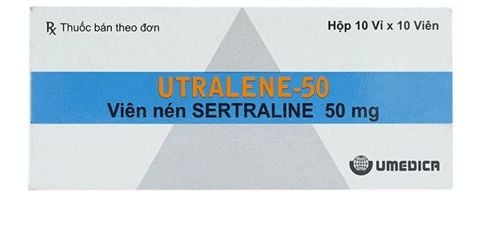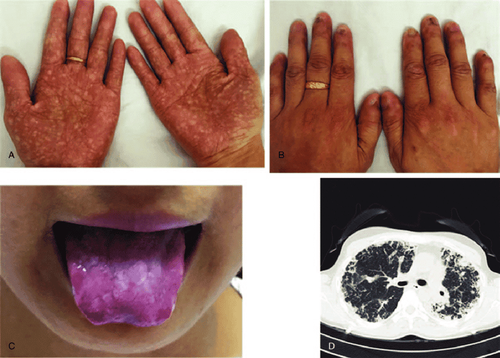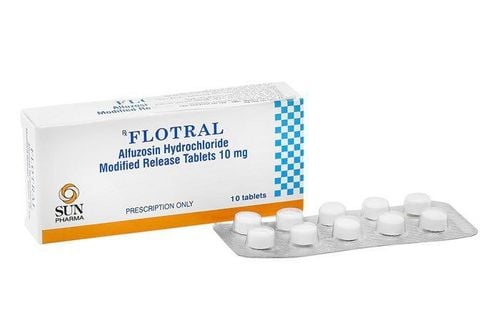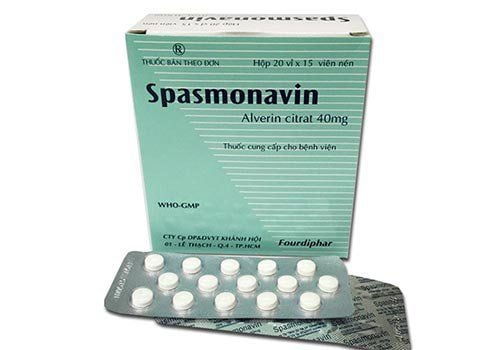This is an automatically translated article.
Campto drug is prepared in the form of a concentrated solution for solution for infusion, the main ingredient is Irinotecan hydrochloride trihydrate. The drug is used in the treatment of advanced colon and rectal cancer.
1. What is the use of Campto?
What is Campto drug? The drug is prepared with a concentrated solution, containing 20mg/ml Irinotecan hydrochloride trihydrate (equivalent to 17.33mg/ml Irinotecan). Campto vial contains 40mg or 100mg Irinotecan hydrochloride trihydrate.
Indications for use of Campto: Treatment for patients with advanced colon - rectal cancer:
Campto is also used in combination with the following drugs:
In combination with cetuximab to treat cancer patients colon-rectal metastasis with wild-type KRAS gene, epidermal proliferation factor receptor expression, untreated metastatic cancer before or after failure of cytotoxic drug therapy contains Irinotecan; In combination with 5-fluorouracil, folinic acid and bevacizumab for first-line treatment of patients with metastatic colon or rectal carcinoma; In combination with capecitabine (with or without bevacizumab) for the first-line treatment of patients with metastatic colorectal carcinoma. Contraindications to the use of Campto:
Patients with chronic inflammatory bowel disease, intestinal obstruction; Patients with a history of severe hypersensitivity to Irinotecan hydrochloride trihydrate or other excipients of Campto; Women who are breastfeeding; Patients with severe bone marrow failure; The patient has bilirubin greater than 3 times the upper limit of the normal range; Patients with WHO activity status > 2; The patient used concurrently with ST John's Wort.
2. How to take Campto
Administer the drug by peripheral or central intravenous infusion, only for adults.
Like other anticancer drugs, Campto must be prepared and handled with caution.
Reconstitution for intravenous infusion:
Campto solution should be prepared under sterile conditions; If a precipitate is observed in the vial or after dilution, the product should be discarded according to standard procedures; Using aseptic technique, withdraw the required amount of Campto solution from the vial using a calibrated syringe, then inject into a 250 ml infusion bag or bottle containing 0.9% sodium chloride solution or 5% glucose solution. Then, mix the infusion solution in a circular motion.
3. Dosage of Campto
3.1 Recommended Dosage In monotherapy for previously treated patients: Use a dose of 350mg/m2, administered intravenously over 30-90 minutes x 3 times/week.
In combination therapy for previously untreated patients:
Campto in combination with 5-fluorouracil/folinic acid in a 2-week dosing course: Campto takes 180mg/m2 x 2 weeks/time by mouth IV infusion over 30-90 minutes. Then perform an infusion of folinic acid and 5-fluorouracil; Campto in combination with cetuximab: Refer to the indications for cetuximab. Usually, the dose of Irinotecan used is similar to that used in the last cycle of the previous Irinotecan-containing regimen. Irinotecan should be administered no earlier than 1 hour after the end of the cetuximab infusion; Campto in combination with bevacizumab: Refer to the indications for bevacizumab; Campto in combination with capecitabine: Refer to capecitabine indications. 3.2 Dosage adjustment Campto should be administered after all adverse events have recovered to NCI-CTC classification (National Cancer Institute General Toxicity) and when treatment-related diarrhea has completely resolved.
When initiating subsequent therapy, the dose of Campto and 5-fluorouracil if administered should be reduced according to the worst grade of adverse events observed from the previous infusion. Treatment should be delayed by 1-2 weeks to allow the patient to recover from treatment-related side effects.
With the following side effects, the dose of Campto should be reduced by 15 - 20% or 5-fluorouracil if necessary:
Hematologic toxicity: Thrombocytopenia, acute leukopenia (grade 4), acute neutropenia 4, neutropenia with fever (grade 3 - 4 neutropenia, grade 2 - 4 fever); Non-hematological toxicity (grade 3 - 4). When changing the dose of cetuximab when used in combination with irinotecan, the indications for cetuximab should be followed.
If Campto is combined with capecitabine for patients over 65 years of age, the starting dose of capecitabine should be reduced to 800mg/m2 x 2 times/day according to the indications for capecitabine. Dosage recommendations for capecitabine combination therapy should be consulted.
3.3 Duration of treatment Campto should be continued until disease progression is achieved to the intended goal or when toxicities are beyond the patient's tolerance.
3.4 Dosage for special patient populations Patients with hepatic impairment: Information is available on treatment with Campto alone, no data on combination therapy. Specifically:
Blood bilirubin levels up to 3 times the upper limit of the normal range in patients with activity status ≤ 2, the starting dose of Campto should be determined. In patients with hyperbilirubinemia and a prothrombin time greater than 50%, the clearance of irinotecan is decreased, increasing the risk of hematologic toxicity. Therefore, weekly blood counts should be monitored in this group of patients; In patients with bilirubin up to 1.5 times the upper limit of the normal range, the recommended Campto dose is 350 mg/m; In patients with bilirubin between 1.5 and 3 times the upper limit of the normal range, the recommended dose of Campto is 200 mg/m; In patients with bilirubin exceeding 3 times the upper limit of the normal range, Campto should not be used. Patients with renal impairment: Campto is not recommended for use in patients with renal impairment because no studies have been performed on its use in this patient population.
Elderly patients: There are no specific pharmacokinetic studies in the elderly. However, the dose should be carefully prescribed in this group of patients due to the higher frequency of impairment of biological function. This group of patients needs to be monitored more closely when taking the drug.
3.5 Campto Overdose There have been reports of potentially fatal Campto overdoses at approximately 2 times the recommended therapeutic dose. Typical side effects are severe neutropenia and severe diarrhea. There is currently no specific antidote for Campto overdose. It is best to take as much supportive care as possible to prevent dehydration from diarrhea and to treat any infectious complications.
4. Side effects of the drug Campto
When treating alone with Campto or in combination with other drugs, patients may experience some side effects such as:
Infection; Blood and lymphatic system: neutropenia, thrombocytopenia, anemia, neutropenia with fever; Metabolism and nutrition: Anorexia; Nervous system: Cholinergic syndrome; Gastrointestinal: Diarrhea, nausea, vomiting, abdominal pain, constipation; Skin and subcutaneous tissue: Hair loss (reversible); General and injection site disorders: Fever, mucositis, asthenia; Laboratory results: Increased blood creatinine, increased transaminase, increased bilirubin, increased alkaline phosphatase in the blood. When experiencing side effects of Campto, patients should notify their doctor early to receive advice on the most appropriate and effective treatment intervention.
5. Be careful when using Campto
Some notes for patients to remember before and while using Campto:
Campto should only be used in medical facilities specializing in chemotherapy for cytotoxic substances, only under the supervision of a doctor. doctors with experience in anti-cancer chemotherapy; Patients should be informed by their doctor about the risk of delayed diarrhea occurring more than 24 hours after taking Campto. Patients need to quickly notify the doctor when having diarrhea for immediate treatment; Patients should have a complete blood count monitored during treatment with Campto. Patients should also be warned by their physician in advance of the risk of neutropenia and fever. In patients with severe hematologic reactions, the dose should be reduced for subsequent administrations. The risk of infection and blood poisoning is increased in patients with severe diarrhea. Patients with severe diarrhea should also have a complete blood count; Liver function tests should be performed at the start of treatment with Campto and before each dosing cycle; Prophylactic treatment with an antiemetic should be given prior to each treatment with Campto. Nausea and vomiting have been reported frequently. Patients with late vomiting and diarrhea should be hospitalized as soon as possible for treatment; If the patient develops an acute cholinergic syndrome (including premature diarrhea, sweating, mydriasis, abdominal cramps, salivation), atropine sulphate 0.25 mg subcutaneously should be used, unless contraindicated. ; When using Campto, patients may develop interstitial lung disease presenting as pulmonary infiltrates (uncommon). Patients with risk factors for the disease (using pulmonary toxicants, radiation therapy, colony-stimulating factors) should be closely monitored for respiratory symptoms before and during Campto; Although Irinotecan is not a blister agent, care should be taken to avoid extravasation and monitor for signs of inflammation at the infusion site. If extravasation occurs, wash the infusion site and apply ice; Patients who have not completed treatment of intestinal obstruction should not use Campto; Using Campto drug may be associated with the risk of increased serum creatinine, increased blood urea nitrogen, acute renal failure,...; Patients who have previously received radiation therapy to the pelvis or abdomen are at increased risk of myelosuppression following the use of irinotecan. Caution should be exercised when using the drug in people who have received multiple previous radiation therapy; There have been cases of myocardial ischemia following treatment with Irinotecan, mainly in patients with underlying heart disease, cardiovascular disease risk factors or prior cytotoxic chemotherapy. Therefore, patients with risk factors should be closely monitored and control measures for modifiable risk factors (eg, hyperlipidemia, hypertension, smoking); Irinotecan has rarely been associated with thromboembolic effects such as arterial thrombosis, pulmonary embolism, venous thrombosis; Concomitant use of Irinotecan with vaccines can lead to serious infection or death. Therefore, live vaccines should be avoided in patients receiving Irinotecan, where dead or inactivated vaccines may be used (although response to these vaccines may be impaired); Campto contains sorbitol, so it is not suitable for patients with hereditary fructose intolerance; Concomitant use of Irinotecan with a strong inhibitor such as ketoconazole or an inducer such as rifampicin, carbamazepine, phenobarbital, phenytoin of CYP3A4 should be avoided because it may alter the metabolism of Irinotecan; Women and men should practice contraception while taking Campto and for at least 3 months after stopping the drug; There are no data on the use of Irinotecan in pregnant women. Because the drug is potentially embryotoxic and teratogenic in animals, it is best not to use Campto in pregnant women unless absolutely necessary, with the approval of a physician; It is not known whether Irinotecan is excreted in human milk. Therefore, breastfeeding should be discontinued while taking Campto; Patients should be warned about the possibility of dizziness, visual disturbances occurring within 24 hours of taking Campto and should not drive or operate machinery if these symptoms occur.
6. Campto drug interactions
Some Campto drug interactions include:
Irinotecan interacts with neuromuscular blocking agents. Because Campto has anticholinesterase activity, it is possible to prolong the neuromuscular blocking effects of suxamethonium and antagonize the neuromuscular blocking effects of non-depolarizing drugs; Concomitant use of anticonvulsants that induce CYP3A (eg, phenytoin, carbamazepine, phenobarbital) may reduce exposure to irinotecan, SN-38, glucuronide SN-38 and induce pharmacodynamic effects; Concomitant administration of ketoconazole may decrease AUC of APC and increase AUC of SN-38 compared with Irinotecan alone; St. John's Wort reduces plasma concentrations of SN-38 (metabolite of Irinotecan); Co-administration of atazanavir sulfate with irinotecan may increase the systemic exposure of SN-38 and should be considered when co-administering these two drugs; The use of anticoagulants is common due to the increased risk of thrombotic events in cancer patients. If vitamin K antagonist anticoagulation is indicated, regular monitoring of INR is required because of the potential for an interaction between oral anticoagulants and cancer chemotherapy; Concomitant use of Campto and yellow fever vaccine is contraindicated because of the increased risk of fatal systemic reactions to the vaccine; Co-administration of Campto with live attenuated vaccines is not recommended because of the increased risk of systemic illness, even death (eg, infection). This risk is increased in patients who are already immunosuppressed due to pre-existing disease. Where this risk exists, an inactivated vaccine can be used; Concomitant use of Irinotecan with phenytoin may increase the risk of more severe seizures due to reduced gastrointestinal absorption of Irinotecan; Concomitant use of Campto with cyclosporin and tacrolimus should be considered with caution because of the potential for excessive immunosuppression with a risk of lymphoproliferative disease. When prescribed to use Campto, patients need to strictly follow the doctor's instructions and coordinate with all recommendations. Patients should not self-medicate with a new drug or change the dose of drugs without the consent of the doctor. At the same time, patients should keep a relaxed, optimistic mood, try to eat and rest more to win cancer.













